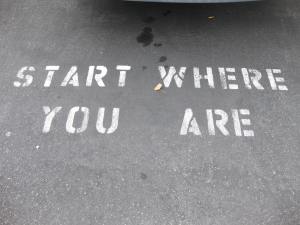 These last few months have been rough for me. Despite being in an overall great place mentally, I have encountered a lot of stress between moving states, starting a new job, one hospitalization, road trips to see my family, etc. These things might not be that stressful on my mind-state, but my increase in HAE attacks shows that I am being affected, even if it’s on a level that I cannot notice any other way. For those that do not know, Hereditary Angioedema is a rare and life threatening genetic blood disease affecting about 1 in 10,000 to 1 in 50,000 people worldwide. Here’s an explanation from the HAE Association:
These last few months have been rough for me. Despite being in an overall great place mentally, I have encountered a lot of stress between moving states, starting a new job, one hospitalization, road trips to see my family, etc. These things might not be that stressful on my mind-state, but my increase in HAE attacks shows that I am being affected, even if it’s on a level that I cannot notice any other way. For those that do not know, Hereditary Angioedema is a rare and life threatening genetic blood disease affecting about 1 in 10,000 to 1 in 50,000 people worldwide. Here’s an explanation from the HAE Association:
HAE patients have a defect in the gene that controls a blood protein called C1 Inhibitor. The genetic defect results in production of either inadequate or non-functioning C1-Inhibitor protein. Normal C1-Inhibitor helps to regulate the complex biochemical interactions of blood-based systems involved in disease fighting, inflammatory response and coagulation. Because defective C1-Inhibitor does not adequately perform its regulatory function, a biochemical imbalance can occur and produce unwanted peptides that induce the capillaries to release fluids into surrounding tissue, thereby causing edema.
People that suffer with hereditary angioedema often experience many health traumas and major hospitalizations early on in life. Considering this, the potential for generalized anxiety disorder and PTSD are very high. This is an area where there is very little dialogue (at least so far) happening in the medical field. So many of us are used to just having to deal with this disease, even encountering doctors that often misdiagnose us or question what we are feeling. We are used to becoming very strong individuals (I like to think of ourselves as warriors 😉 ) and come up with our own ways of handling the stress, anxiety, and trauma. A whole other can of worms is the tendency for HAE patients to develop a codependency addiction, but I will save that one for another time.
My goal here today is to explore what we can do to survive and heal these moments of intensity in our lives. I have been making the conclusion over and over again, that besides my yoga practice, what keeps me sane is the practice of mindfulness meditation. Psychology Today has a great article on mindfulness meditation and how to practice it. The best and most simple explanation that I have found on the method is from Vietnamese Zen Buddhist Monk, Thich Nhat Hanh. He says:
The exercise is simply to identify the in-breath as in-breath and the out-breath as the out-breath. When you breathe in, you know that this is your in-breath. When you breathe out, you are mindful that this is your out-breath.
Just recognize: this is an in-breath, this is an out-breath. Very simple, very easy. In order to recognize your in-breath as in-breath, you have to bring your mind home to yourself. What is recognizing your in-breath is your mind, and the object of your mind—the object of your mindfulness—is the in-breath…
So the object of your mindfulness is your breath, and you just focus your attention on it. Breathing in, this is my in-breath. Breathing out, this is my out-breath. When you do that, the mental discourse will stop. You don’t think anymore. You don’t have to make an effort to stop your thinking; you bring your attention to your in-breath and the mental discourse just stops. That is the miracle of the practice. You don’t think of the past anymore. You don’t think of the future. You don’t think of your projects, because you are focusing your attention, your mindfulness, on your breath.
 It is that simple. The beauty of this simplicity is that there is no excuse not to cultivate it. The breath is always there so this practice is always available to us. We don’t need some elaborate alter, a fancy meditation cushion, or a zen gong alarm clock. All we need is the breath and the intention to become aware of it. I firmly believe that this is a practice everyone can benefit from, not just people suffering with HAE or any other trauma. When we cultivate more inner peace, we are contributing to the overall peace of the world. And who doesn’t think we could all benefit from that?
It is that simple. The beauty of this simplicity is that there is no excuse not to cultivate it. The breath is always there so this practice is always available to us. We don’t need some elaborate alter, a fancy meditation cushion, or a zen gong alarm clock. All we need is the breath and the intention to become aware of it. I firmly believe that this is a practice everyone can benefit from, not just people suffering with HAE or any other trauma. When we cultivate more inner peace, we are contributing to the overall peace of the world. And who doesn’t think we could all benefit from that?
Now, for my fellow swell buddies– When do we meditate? Ideally we create a consistent practice for the same time each day, preferably right in the morning. But there are many other times too.
- Those moments when you’re experiencing airway paranoia. You know the times– “What’s that tickle in my throat?” “Is my airway closing?” “Is this just a sore throat?” “AHHHH Intubation!” I know many people can relate to this, even if some have never had an airway swell. Unless your airway is actually closing, we can all take five minutes to sit and breathe. Another amazing thing about this practice is that we can all experience heightened awareness and can better determine if this is an actual attack, or if we are just freaking out.
- The ER. Oh yes. We are all veryyyyyyy familiar with these! Sometimes they are places where we find a true sense of peace, more often than not though, they are really intense and stressful places. Finding the right doctor. Knowing more about your disease than the people who are sticking needles in you. Hearing other people crying or wailing or vomiting. The florescent lights. The constant beeping. Even here we can take the time to pause and connect with our breath.
- When the insecure thought tangents start. “Will this person accept me when they find out I have this disease?” “Will I pass this on to my kids?” “Am I wrong for passing this on to my kids?” “Am I bipolar because I’m freaking the F out?” “Is it wrong to feel scared?” “Does anyone understand?” Unfortunately this inner dialogue is a side-effect of trauma and a process most of us have to work through. When we take the moment to pause and breathe, we can allow ourselves to detach from the negative thought stream. We can at least look at them as if they are not us, but just a thought we are having. They will pass.
There are many other times when we can use this practice to our benefit, but we all need to learn to be our own judge of that. I am not perfect. I am not in a place of perfect peace about Hereditary Angioedema. In fact, this blog is coming out of a very long night of an emotional breakdown. I was completely and utterly exhausted and yet, I could not fall asleep. Which starts the very vicious cycle of emotional distress. All the negative thought patterns start arising, the anxiety kicks in, I become upset and cry. Which makes me only fear swelling more to point where I eventually do start to swell. My point in being honest is that these difficult moments will come. Again and again. Breakdowns and pain will happen. ER visits are likely. Wanting to give up will happen. But through mindfulness and learning how to be with ourselves, we can be happier. We can be healthy in many other ways. We can be secure in who we are, and we can cultivate a sense of inner peace.
Living with Hereditary Angioedema is not easy and sometimes we are not always capable of being these amazing and strong warriors. We need to allow ourselves to be supported. We need to take partners that love us and are willing to put up with the antics. We need to take care of our bodies. We need to look at the food we eat as medicine. We need to exercise and stretch carefully. We need to live this life to the fullest. We need to give back an help others. We need to be grateful. And we need our breath.
Dare to Be
When a new day begins, dare to smile gratefully.
When there is darkness, dare to be the first to shine a light.
When there is injustice, dare to be the first to condemn it.
When something seems difficult, dare to do it anyway.
When life seems to beat you down, dare to fight back.
When there seems to be no hope, dare to find some.
When you’re feeling tired, dare to keep going.
When times are tough, dare to be tougher.
When love hurts you, dare to love again.
When someone is hurting, dare to help them heal.
When another is lost, dare to help them find the way.
When a friend falls, dare to be the first to extend a hand.
When you cross paths with another, dare to make them smile.
When you feel great, dare to help someone else feel great too.
When the day has ended, dare to feel as you’ve done your best.
Dare to be the best you can –
At all times, Dare to be!
― Steve Maraboli
For more information on Hereditary Angioedema and how you can help, please visit the HAEA webiste.